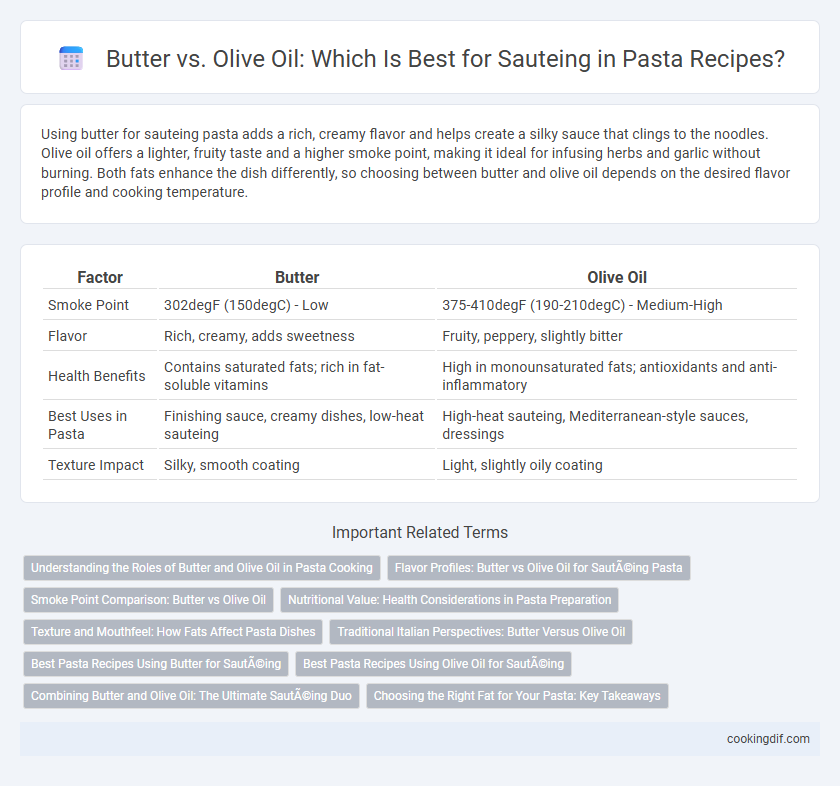Using butter for sauteing pasta adds a rich, creamy flavor and helps create a silky sauce that clings to the noodles. Olive oil offers a lighter, fruity taste and a higher smoke point, making it ideal for infusing herbs and garlic without burning. Both fats enhance the dish differently, so choosing between butter and olive oil depends on the desired flavor profile and cooking temperature.
Table of Comparison
| Factor | Butter | Olive Oil |
|---|---|---|
| Smoke Point | 302degF (150degC) - Low | 375-410degF (190-210degC) - Medium-High |
| Flavor | Rich, creamy, adds sweetness | Fruity, peppery, slightly bitter |
| Health Benefits | Contains saturated fats; rich in fat-soluble vitamins | High in monounsaturated fats; antioxidants and anti-inflammatory |
| Best Uses in Pasta | Finishing sauce, creamy dishes, low-heat sauteing | High-heat sauteing, Mediterranean-style sauces, dressings |
| Texture Impact | Silky, smooth coating | Light, slightly oily coating |
Understanding the Roles of Butter and Olive Oil in Pasta Cooking
Butter imparts a rich, creamy flavor and a smooth texture to pasta dishes, enhancing the overall mouthfeel with its natural milk solids that caramelize during sauteing. Olive oil offers a robust, fruity taste along with a higher smoke point, making it ideal for sauteing garlic or vegetables without burning. Combining butter and olive oil balances the richness and aroma, creating a versatile base that elevates pasta sauces and retains moisture in the dish.
Flavor Profiles: Butter vs Olive Oil for Sautéing Pasta
Butter imparts a rich, creamy flavor with subtle nutty undertones that enhances the natural sweetness of pasta dishes, making it ideal for creamy sauces and delicate ingredients. Olive oil offers a fruity, slightly peppery taste that adds a Mediterranean depth and complements tomato-based or vegetable-heavy pasta recipes. Choosing between butter and olive oil for sauteing pasta depends on the desired flavor profile and the type of sauce being paired.
Smoke Point Comparison: Butter vs Olive Oil
Olive oil has a higher smoke point, typically around 375-420degF (190-215degC), making it more suitable for sauteing pasta without burning. Butter's smoke point ranges from 300-350degF (150-175degC), causing it to brown and burn faster during high-heat cooking. Choosing olive oil helps maintain flavor and nutritional quality while preventing the acrid taste associated with burnt butter.
Nutritional Value: Health Considerations in Pasta Preparation
Butter contains saturated fats and provides vitamins A and D, which can enhance flavor but may impact heart health when consumed in excess. Olive oil is rich in monounsaturated fats and antioxidants, offering anti-inflammatory properties that promote cardiovascular health during pasta preparation. Choosing olive oil for sauteing pasta ingredients supports a balanced diet with beneficial nutrients that align with heart-healthy eating guidelines.
Texture and Mouthfeel: How Fats Affect Pasta Dishes
Butter imparts a rich, creamy texture to pasta dishes, creating a velvety mouthfeel that enhances the overall indulgence. Olive oil offers a lighter, silkier coating, providing a smoother and less heavy sensation on the palate. The choice between butter and olive oil directly influences the pasta's moisture retention and how flavors meld with each bite.
Traditional Italian Perspectives: Butter Versus Olive Oil
Traditional Italian cuisine predominantly favors olive oil over butter for sauteing pasta dishes, particularly in central and southern regions where olive oil is abundant and integral to the Mediterranean diet. Olive oil imparts a distinct fruity flavor and healthier monounsaturated fats, aligning with Italy's culinary emphasis on fresh, natural ingredients. Northern Italian recipes may incorporate butter, especially in richer sauces, but olive oil remains quintessential for authentic, light sauteing techniques.
Best Pasta Recipes Using Butter for Sautéing
Butter offers a rich, creamy flavor that enhances the texture and taste of pasta dishes like garlic butter shrimp linguine and fettuccine Alfredo. Its natural milk solids brown during sauteing, creating a nutty depth that pairs perfectly with herbs such as sage and thyme. Recipes like brown butter gnocchi and butter garlic scallops highlight the luscious mouthfeel and aromatic qualities butter imparts compared to olive oil.
Best Pasta Recipes Using Olive Oil for Sautéing
Olive oil is prized in the best pasta recipes for sauteing due to its rich flavor and health benefits, enhancing dishes like aglio e olio or penne with sun-dried tomatoes. Its higher antioxidant content compared to butter supports heart health while providing a robust, fruity taste that complements garlic and herbs. Using extra virgin olive oil at moderate heat preserves its nutritional properties and elevates the overall pasta experience with a smooth, aromatic finish.
Combining Butter and Olive Oil: The Ultimate Sautéing Duo
Combining butter and olive oil creates the ultimate sauteing duo for pasta, balancing rich flavor with a higher smoke point. Butter infuses a creamy, nutty taste while olive oil ensures even cooking without burning. This blend enhances the texture and aroma of sauteed ingredients, elevating any pasta dish to gourmet quality.
Choosing the Right Fat for Your Pasta: Key Takeaways
Butter provides a rich, creamy flavor that enhances pasta dishes with a smooth texture and slightly nutty aroma, ideal for delicate sauces like Alfredo or carbonara. Olive oil offers a lighter, fruitier taste with health benefits such as antioxidants and monounsaturated fats, making it perfect for Mediterranean-inspired pasta recipes. Selecting the right fat depends on the desired flavor profile and texture, with butter best for richness and olive oil for a fresh, vibrant finish.
Butter vs olive oil for sautéing Infographic

 cookingdif.com
cookingdif.com